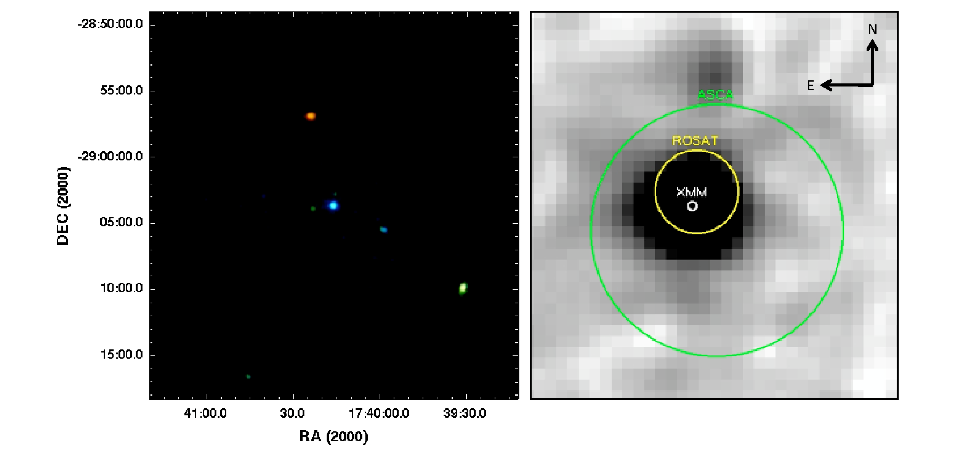2XMM J174016.0−290337
Also known as: most likely AX J1740.3-2904 and AX J1740.2-2903
Monitoring data:
Coordinates
RA 17h 40m 16.0s -29° 03' 38" Simbad
Binary System
- Compact object: Possibly, white dwarf [1]
Orbit
Optical companion
Description
2XMM J1740.2-2903 is an low mass X-ray source with a possible white dwarf as the compact object discovered by ASCA during the Galactic center region scans [2]. It is listed in the latest IBIS survey catalog [3] with a 20–40 keV flux of 0.5 mCrab or 3.8×10−12 erg cm−2 s−1. 626 sec period detected by [1] in XMM data. Nature of system not clear, period could be either very fast orbital period in a ultra-compact system or pulse period of a neutron star. However, no early type star known in the error circle. Possible conclusion to have a late type star - neutron star system, e.g. a symbiotic X-ray binary.
 Fig 1. Left: Combined (MOS1 & MOS2) EPIC RGB (Red: 0.2 – 1 keV, Green: 1 – 2 keV, Blue: 2 – 10 keV) image showing a ∼28′ × 28′ field centered on 2XMM J174016.0−290337. The image has been Gaussian smoothed with a kernel radius of 3 pixels. Right: EPIC image showing the positions of the previously detected X-ray sources AX J1740.2−2903 (ASCA, green circle), AX J1740.3−2904 (ROSAT, yellow circle) and the new XMM-Newton position (XMM, white circle). The circle radii represent the 90% errors in each case. MOS1/MOS2/EPIC intruments on board the XMM-Newton Telescope[1]
Fig 1. Left: Combined (MOS1 & MOS2) EPIC RGB (Red: 0.2 – 1 keV, Green: 1 – 2 keV, Blue: 2 – 10 keV) image showing a ∼28′ × 28′ field centered on 2XMM J174016.0−290337. The image has been Gaussian smoothed with a kernel radius of 3 pixels. Right: EPIC image showing the positions of the previously detected X-ray sources AX J1740.2−2903 (ASCA, green circle), AX J1740.3−2904 (ROSAT, yellow circle) and the new XMM-Newton position (XMM, white circle). The circle radii represent the 90% errors in each case. MOS1/MOS2/EPIC intruments on board the XMM-Newton Telescope[1]
Flux/Luminosity
X-rays: 3.4x10-12 ergs cm-2s-1 (1-10 keV) with XMM-Newton. [1]
On INTEGRAL/IBIS observations see also [4].
References
- ↑ 1.0 1.1 1.2 1.3 1.4 1.5 Farrell S.A., Gosling A. J., Webb N. A., et al., 2010, astro-ph:1008.4352 (NASA ADS)
- ↑ Sakano, M., Koyama, K., Murakami, H., Maeda, Y., Yamauchi, S. 2002, APJS, 138, 19 (NASA ADS)
- ↑ Bird, A. J., Bazzano, A., Bassani, L. et al. 2010, ApJS, 186,1 (NASA ADS)
- ↑ Malizia, A., Bassani, L., Sguera, V., et al., 2010, MNRAS, 408, 975 (NASA ADS)